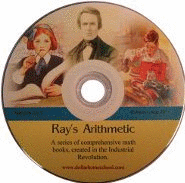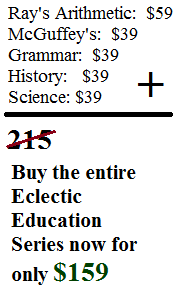|
Dollar
Homeschool Bringing Back American Education |
|
|
||||
Eclectic Education
Series The Homeschool
Blog The Homeschool
Blog |
How memory works; and what math programs like Saxon math get wrong. Memories are most easily and readily formed when the information to be remembered is related to something which is already understood. A study was done to find out whether chess players had better memories than other people. In order to find out the examiners would set up a chess board with the pieces on the board in different locations, let the person study the position for a few moments, and then they were given a blank board with the pieces and told to set up the position they had just seen. What they found was that the chess players were able to remember how to set up the pieces much better than a normal person, but only under certain conditions. The position on the board had to make sense as a chess position. If the pieces were simply scattered across the board in an inharmonious mess, with white and black randomly placed across the board, then the chess players were suddenly at about the same level as a normal person when it came to remembering where the pieces were. Chess operates under a strict set of rules, and therefore common patterns are formed when playing. What makes a strong player better than a weak player is often simply that they have memorized more and better patterns than their opponent. This is often almost totally sub-conscious. Therefore, what the chess players were doing in the rational chess positions was not so much remembering the positions of the pieces, what they were remembering was the relationships of the pieces to each other. 'This bishop was pinning a knight to a queen on this diagonal, and the knight was protected by the queen and a pawn.' These relationships occur often in chess games, and so the chess player was immediately able to recognize them and their minds were able to relate the position to many it had already seen. A more simplified example of this you can try for yourself would be to draw a board with black and white squares, like a chess board. Now draw another board in which all the squares, instead of being black, white, black, white, are instead randomly changed so that they follow no set pattern. You don't have to have as many black squares as white, or any other rule. It would be much more difficult to remember a board like that right? So from this we can draw a conclusion that our memory works best and most easily when it can relate the information presented to something it already knows, something which follows rules it understands. This is why memory 'tools' such as putting information to song works so well. Instead of simply memorizing facts on their own, by putting the facts to a simple song, like the alphabet song, our memory can relate the information to something else we know. It doesn't really even need to be a song, simply a cadence or a rhythm will do the trick. A simple exercise will show how this works. Repeat the alphabet, without any song, just the letters. Now try and repeat the same letters, backwards. You probably already know how much more difficult it is. Why? They are the same letters, you definitely know them, you use them all the time. But to remember all of those sounds you were taught them in a set order with a certain rhythm to saying them. To remove those letters and their sounds from that rhythm is to remove the relationship your mind had made with them. Now how is this related to studying math? Most mothers already know that when learning to count or add, real objects like blocks can be used to help the child understand and bridge the gap between the abstraction of the number and the actual reality of the process. 'This is the number 3. These are 1, 2, 3 blocks.' After the child has bridged the gap somewhat between objects and abstract numbers, then addition is added. Then subtraction. Then multiplication, because multiplication is related to addition. Then division is taught, because division is related to multiplication. What the mother is doing is relating the new information she is teaching to what the child already knows. Now the more disjointed information is, the more repetitions it takes to memorize. It is for this reason it's such a big step to move from addition to multiplication, especially with the big numbers from 7 to 12. Up until about the number 5 or 6 children will often simply add the numbers quickly in their head rather than memorize the answer. So instead of memorizing that 3x4 is 12, they will simply add 4+4+4 and tell you the answer is twelve. This is why flash cards are so useful when learning the multiplication and division facts through the 12's by rote. With flash cards, that problem can be presented to him many times until he can remember it without relying on any other process than memory. Saxon Math, and many other similar math books present a new lesson each day, with a different type of problem than the one before. Then, so that type of problem is not forgotten, it is repeated with small changes lesson after lesson, sometimes for the rest of the book, similar to the flash card method. This method usually works, at the lower level of math at least, but most students encounter a problem, especially as they reach the more difficult areas of mathematics such as algebra. The problem students encounter is that as they learn more and more math, the number of different types of problems they encounter increases exponentially, and each new lesson they encounter teaches a new unrelated type of problem. Of course, you could say all the math is related because it is all mathematics. But at a certain point, usually about Algebra ½, the number of different types of problems becomes overwhelmingly difficult to handle. Geometry, Algebra, then in the next books the beginnings of Calculus are all presented in a disjointed manner, in order of 'difficulty' instead of by concept. Because the lessons do not build upon each other in a sequential manner, learning is stilted and slow for many children using these textbooks. From my own experience, what I found was that I began to spend more and more time finding the old lessons in the math book that taught the problem I was trying to solve, in order to 'jog' my memory as to what the process was to solve it. I used Saxon Math all through high school, and finally gave up on math when I reached the book Advanced Mathematics. At that point I was spending 5 hours a day in order to work a single lesson with 30 problems. From many other home school moms and children I have learned that they often switched math series at about Algebra ½ from Saxon for this same reason. Remember the Chess board with the pieces. It was much easier for the chess players to remember what the rational looking positions were than to remember the random ones. This is because they could relate the position to the foundation of knowledge they already had. What makes the Ray's books better than the rest, is that they don't jump from subject to subject. Instead they teach a student until he has mastered to a high degree a certain type of problem before moving on to another type. This method is much faster and more efficient. When the Ray's books were first used in the US, it was rare for anyone to have the luxury of an 8-9 month school year. The children were needed to work on the farm and to help the family. Schooling usually took place during the winter, and often lasted no longer than 2-3 months out of a year, and yet by the time they were in high school they were better educated than many of our college students today. This was possible because of the strict discipline enforced in the schools, and because the books used to present the subjects were also extremely disciplined in their approach to the different subjects, allowing for a high degree of learning in a very short amount of time. A great resource for quality educational books for your homeschool is the Eclectic Education Series, a collection of books which provided Americans with some of the best educations in the world, before John Dewey and the demise of American education. Click Here to learn more. |
 |
|
|
|
|
|
|
|
|
|
|
|
|
|
|
|
 |
|||||||
|
|||||||
|
|||||||
|
|||||||
© Copyright Dollar Homeschool, 2009. All
Rights Reserved.